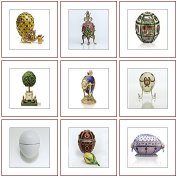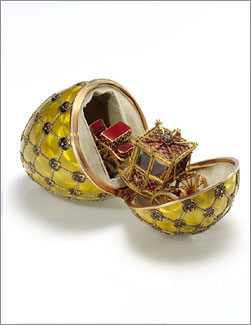Faberge Imperial Easter Eggs
www.Gatchino.com/Jeweller/Faberge/

FabergeImperialEasterEggs
Императорские пасхальные яйца Фаберже
Imperial Treasures: Faberge from the Forbes Collection
Императорские сокровища: Фаберже из коллекции Форбса
The Coronation Egg
Яйцо «Коронация»
На Sotheby's был объявлен аукцион: Sale N07981 April 20-21, 2004.
Но аукционному дому сделали предложение, от которого он не мог отказаться.
О сенсационной продаже-покупке было объявлено 4 февраля 2004 года.

© 2004 Sothebys.com
© 2004 Mr. Victor Vekselberg's Foundation

A Faberge Imperial Easter Egg presented by Tsar Nicholas II to his wife the Empress Alexandra Feodorovna at Easter 1897. Nicholas loved the pomp and ritual of military life and Imperial ceremony, which required him only to look good and say little. On May 9, 1896, Nicholas and Alexandra were crowned in the Uspenski Cathedral in Moscow in one of the most magnificent pageants in Russian history. Attended by over seven thousand guests from around the world, including most of Europe's royalty, the celebrations lasted for two weeks. To commemorate the event, Faberge's Coronation egg (1897) was larger and more lavish than any before. The surface was enameled primrose yellow in a field of starbursts. Trellised with bands of laurel made of gold, each intersection was marked by Imperial eagles bearing tiny diamonds on their chests. But the surprise inside was an even greater achievement: a precise reproduction - under four inches long - of the eighteenth-century coach that carried Alexandra to her coronation. According to author Lynette Proler, "It was all done by hand and crafted by hand in such minute detail - every detail from the state carriage was included - from the little crown on the top of it in diamonds to the windows in rock crystal. And the little steps... when the Empress would alight from the carriage onto the steps, they would fall out of the carriage, and in the little miniature they do the same. It took approximately fifteen months to craft this carriage by hand working all day and well into the night, seven days a week, and it was barely finished just in time to be presented to the Empress." The original carriage was designed for Nicholas' great-great-great-grandmother, Catherine the Great in 1793. During the time it took to complete, master craftsman George Stein made numerous clandestine visits to the imperial stables in order to perfectly match his work to the original. The model mimics every moving part of its prototype, right down to a working suspension. (Ironically, when the Hermitage recently undertook to refurbish the original, Margaret Kelly, Director of the Forbes Magazine Collection, provided them with detailed photos of the Coronation egg from which to work.)
 |
 |
 |
1. The Coronation Egg / Яйцо «Коронация»
2. The Lilies of the Valley Egg / Яйцо «Ландыши»
3. The Fifteenth Anniversary Egg / Яйцо «Пятнадцатилетний юбилей»
4. The Orange Tree (Bay Tree) Egg / Яйцо «Апельсиновое (Лавровое) дерево»
5. The Cuckoo (Cockerel) Egg / Яйцо «Петушок»
6. The Order of St. George Egg / Яйцо «Орден Святого Георгия»
7. The Hen Egg: The First Imperial Egg / «Яйцо с курицей» (первое яйцо)
8. The Rosebud Egg / «Яйцо с бутоном розы»
9. The Renaissance Egg / Яйцо «Ренессансc» (Ренессансное яйцо)
- List of Faberge eggs and their current whereabouts
- Список пасхальных яиц Фаберже и их текущего местонахождения